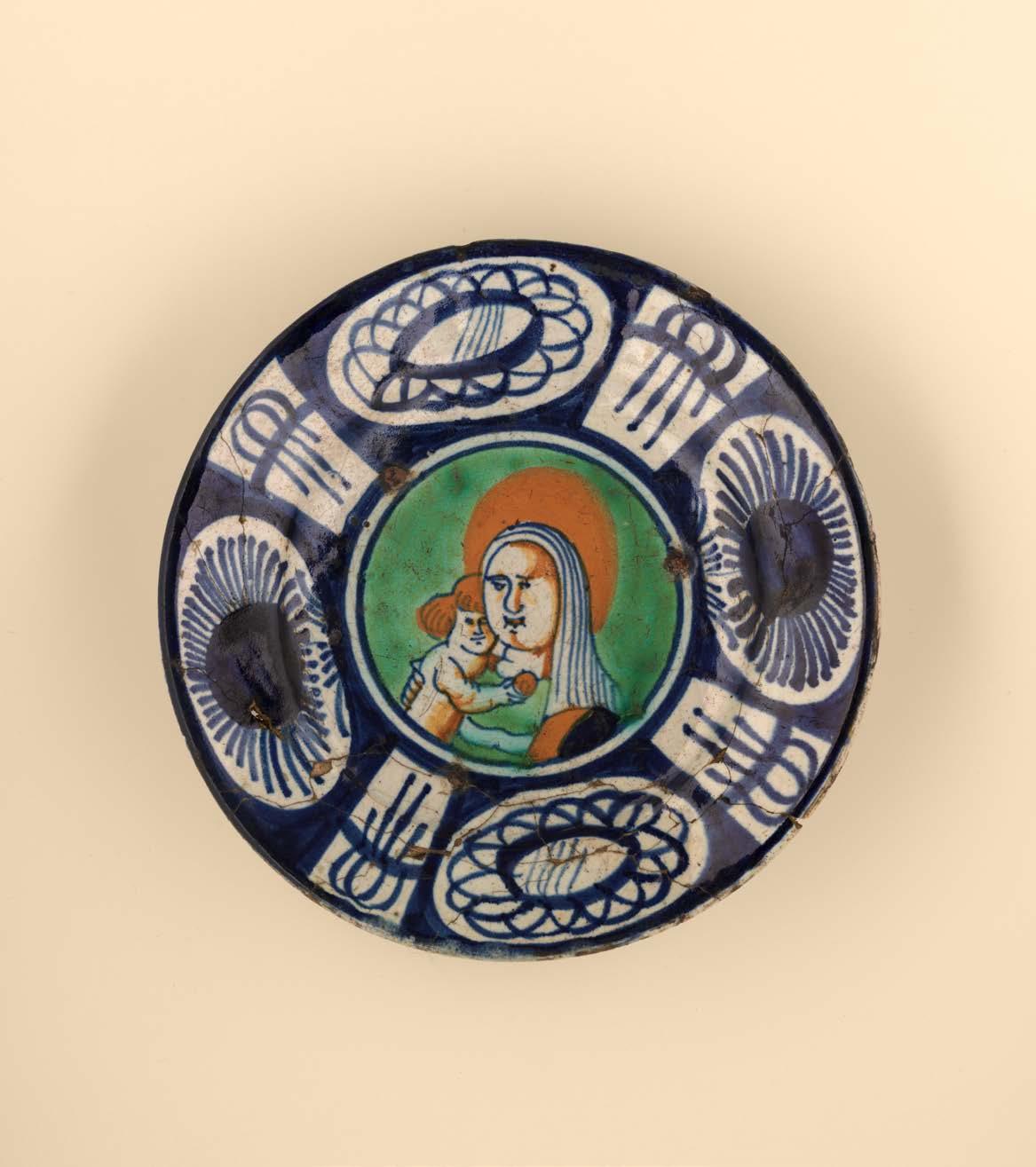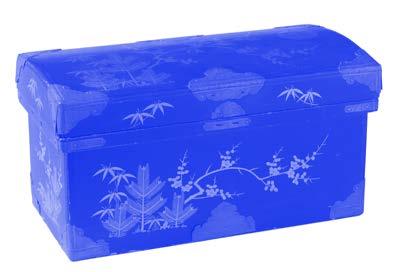Keramiek Ceramics
Aardewerk Earthenware Porselein Porcelain
Steengoed Stoneware
dik thick dun thin broos brittle sterk strong
waterdoorlatend permeable waterdicht watertight
gebakken op fired at ca. 800-1150ºC
gebakken op fired at ca. 1350-1500ºC
haar objecten juist zichtbaar maken hoezeer culturen met elkaar verwant en versmolten zijn. Ze ziet keramiek maken als een universele taal, die iedereen kan leren spreken en die in uiteenlopende gemeenschappen op gelijksoortige wijze wordt toegepast.
In haar vroege werk vertaalt Moniz deze visie door bevriende kunstenaars en ontwerpers uit te nodigen om haar vazen samen te voorzien van een beeldverhaal (afb.3) Uiteenlopende verhalen van verschillende individuen verworden op haar grootschalige objecten tot één. Voor meer recent werk bestudeert Moniz in verschillende landen traditionele maaktechnieken, waaromheen zich gemeenschappen hebben gevormd. Zo ging ze in de leer bij gemeenschappen in Marokko, Zuid-Korea en Japan, op zoek naar vormen, symbolen en waarden die ons als mensen binden. De objecten die Moniz naar aanleiding van deze verkenningen maakt ademen traditioneel vakmanschap (afb.4). Ze zijn met de hand opgebouwd en deels of niet geglazuurd. Universele basiselementen uit het maakproces – zoals de hand van de maker, de kleur en de textuur van de klei – blijven zo zichtbaar.
In her early work, Moniz expressed this view by inviting artist and designer friends to provide her vases with a visual narrative (ill.3). Different stories by different individuals blend into one on her large-scale objects. For more recent work, Moniz studies traditional creative techniques, around which communities have formed, in several countries. She was an apprentice in communities in Morocco, South Korea and Japan, in search of forms, symbols and values uniting us as people. The objects Moniz makes in response to these explorations radiate traditional artisanship (ill.4). They are constructed by hand and either partially glazed or not at all. In this way, universal basic elements of the creative process – such as the hand of the maker, the colour and texture of the clay – remain visible.
Leren door te doen
Om de uiterlijke kenmerken van porselein dichter te benaderen dan met majolica mogelijk is, ontwikkelden Nederlandse plateelbakkers rond 1620 een nieuw type aardewerk. Ze ontdekten dat ze dunner aardewerk konden maken door aan hun klei Doornikse aarde met mergel toe te voegen, wat een minder vet mengsel opleverde. Het eenmaal gebakken aardewerk dompelden ze volledig onder in een bad van vloeibaar tinglazuur. Het tinglazuur bestond uit masticot, dat weer is samengesteld uit zand en zouten, en tinas, een mengsel van lood en tin. Om voorwerpen extra glans te geven voegden ze een laag transparant loodglazuur toe. Het geglazuurde aardewerk stapelden de plateelbakkers niet langer op met proenen. Ze legden het in plaats daarvan op pennen die in een koker werden gestoken, zodat het witte glazuur alleen aan de achterkant wordt onderbroken.
Learning by Doing
Around 1620, in order to get closer to the visible characteristics of porcelain than is possible with maiolica, Dutch potters developed a new type of earthenware. They discovered they could make a thinner earthenware by adding to their clay soil with marl from Tournai, resulting in a mixture that was less fatty. When the earthenware had been fired once, they immersed it completely in a bath of liquid tin glaze. The tin glaze consisted of massicot, which in turn is composed of sand and salts, and a mixture of lead and tin. To give the objects extra gloss, a layer of transparent lead glaze was added. The Delftware potters no longer stacked the glazed earthenware using spurs. Instead, they placed them on pegs that were stuck into a saggar, so the white glaze would only be interrupted on the back.
5. Onbekend (China), Kalebasvormige vaas
Unknown (China), Gourd-shaped vase
porselein porcelain
Ca. 1635-1645
6. Plateelbakkerij
De Grieksche A, Flesvaas Delftware factory
The Greek A, Bottle vase
aardewerk, tinglazuur earthenware, tin glaze
1678-1686
7. Onbekend (Delft), naar Leonaert Bramer (1596-1674)
Unknown (Delft), after Leonaert Bramer (1596-1674)
aardewerk, tinglazuur earthenware, tin glaze
Ca. 1660-1670
8. Olivier van Herpt, Arcanum porselein porcelain
2017
9. Olivier van Herpt, Blue and White porselein porcelain
2018
7. 9.
Dit vroeg 17de-eeuwse bordje combineert een op het Chinese Kraakporselein geïnspireerde rand met het typisch Christelijke motief van Maria-met-kind. Twee culturen ontmoeten elkaar.
This early 17th-century dish combines a border inspired by Chinese Kraak porcelain with the typically Christian motif of the Virgin and Child. Two cultures meet.
Yuro Moniz ziet keramiek maken als een universele taal.
Ze zoekt naar maaktechnieken, vormen en symbolen die mensen uit verschillende culturen met elkaar delen.
Yuro Moniz sees making ceramics as a universal language. She looks for creative techniques, shapes and symbols people from different cultures have in common.
Eind 17de eeuw maakten Delftse plateelbakkerijen grote, uitbundige vazen met tuiten, die uit verschillende delen bestaan. Het zijn technische hoogstandjes.
At the end of the 17th century, Delftware potters made large, exuberant vases with spouts, consisting of several parts. They were technical tours de force.
Octave Rimbert-Rivière ontwerpt bizarre gebruiksobjecten met behulp van 3D-software. Hij realiseert zijn ingewikkelde ontwerpen door gebruik te maken van verschillende, zelfgemaakte mallen.
Octave Rimbert-Rivière designs bizarre utilitarian objects with the help of 3D software. He realizes his complicated designs by making use of a variety of self-made moulds.
21. Viktor Hachmang i.s.m./with Gen-emon, Intruder porselein porcelain
2019
22. Viktor Hachmang i.s.m./ with Gen-emon, Thieving Magpies porselein porcelain 2019
23. Viktor Hachmang i.s.m./with Gen-emon, Tsuyu porselein porcelain 2019
24. Lisa Konno i.s.m./with Yamatatsu en/and Bunshogama, Mirror selfie porselein, hout, spiegel, webcams porcelain, wood, mirror, webcams
2022-2023
25. Simone Post i.s.m./with Yamatatsu en/and Kinemon, Flagship Pitcher porselein porcelain 2023
26. Onbekend (Japan), Kistje
Unknown (Japan), Chest lakwerk lacquer
Ca. 1600-1700
27. Onbekend (China), Vierkante vaas met vogels bij bloemtakken
Unknown (China), Square vase with birds and flower branches
porselein porcelain
Ca. 1700
28. Onbekend (Delft), Koffiekan
Unknown (Delft), Coffee pot
aardewerk, glazuur earthenware, glaze
Ca. 1700-1730
29. Onbekend (Delft), Borstelrug
Unknown (Delft), Brush back
aardewerk, glazuur earthenware, glaze
Ca. 1700-1730
30. Plateelbakkerij De Grieksche A, Theepot Delftware factory De Grieksche A, Tea pot
aardewerk, tinglazuur earthenware, tin glaze 1701-1722
31. Yoon Seok-hyeon, OTT/ Another Paradigmatic Ceramic
porselein, hars porcelain, resin 2021
De Delftse plateelbakkers pasten zogenaamde ‘chinoiseriedecors’ toe op voorwerpen met een typisch Europese vorm, zoals lampetkannen en -schalen.
The Delftware potters applied so-called ‘chinoiserie’ decoration to objects with characteristically European shapes, like jugs and basins.
Modeontwerpster Lisa Konno doet in de Creative Residency Arita onderzoek naar de Japanse schoonheidsidealen. Mirror selfie bestaat uit een porseleinen masker, een spiegel, en webcams.
Fashion designer Lisa Konno carried out research on Japanese ideals of beauty at the Creative Residency Arita. Mirror selfie consists of a porcelain mask, a mirror and webcams.
Simone Post experimenteert in Arita met het knopen van klei. De gebruikte kleuren verwijzen naar de landen die in de 17de eeuw direct of indirect verbonden waren door de porseleinhandel.
Simone Post experimented with knots of clay in Arita. The colours used refer to the countries directly or indirectly linked by the trade in porcelain during the 17th century.
Rink Schelling (Studio Rink) maakt objecten van ongefilterde, Nederlandse zeeklei. De eigenschappen van dit lokale materiaal zijn leidend in haar maakproces.
Rink Schelling (Studio Rink) makes objects of unfiltered, Dutch sea clay. The characteristics of this local material determine her creative process.
Zogenaamde ‘misbaksels’ zijn in de oven kapotgegaan, bijvoorbeeld doordat een koker met borden is ingestort. Dergelijk productieafval werd veelal weggegooid.
So-called ‘misfirings’ were damaged in the kiln, for example, when a saggar with dishes collapsed. Such production waste was usually discarded.
Fabrique Publique en Coudre gebruiken afgedankt keramiek als grondstof voor Reprint Ceramics, een serie ge-3D-printe lampenkappen.
Fabrique Publique and Coudre use discarded ceramics as raw material for Reprint Ceramics, a series of 3D-printed lampshades.
Voor zijn serie Bodem verpulvert Max Lipsey tweedehands keramiek dat hij in kringloopwinkels vindt.
For his series Bodem, Max Lipsey crushes second-hand ceramics he finds in thrift shops.
Er was veel brandstof nodig om de kamergrote ovens, waarin Delfts aardewerk minstens twee keer werd gebakken, op te stoken. Kwaartkokers beschermden het aardewerk tegen rookgassen.
Lots of fuel was needed to stoke the kilns the size of rooms in which Delft earthenware was fired at least twice. Saggars protected the earthenware from flue gases.
‘Rauwglazuren’ is het direct glazuren van ongebakken aardewerk, zodat het maar één keer gestookt hoeft te worden. Benedetta Pompili blaast deze techniek met Raw.obj nieuw leven in.
‘Raw glazing’ is the immediate glazing of unfired earthenware, so the kiln only has to be stoked once. Benedetta Pompili is breathing new life into this process with Raw.obj.
61. Plateelbakkerij De Porceleyne Schotel, Paar plastieken in de vorm van paarden
Delftware factory De Porceleyne Schotel, Pair of sculptures of horses
aardewerk, tinglazuur earthenware, tin glaze
1724-1764
62. Onbekend (Delft), Paar miniatuurschoenen
Unknown (Delft), Pair of miniature shoes
aardewerk, tinglazuur earthenware, tin glaze 1758
63. Onbekend (Nederland), Poppenhuis van Petronella Oortman Unknown (Netherlands), Dolls’ house of Petronella Oortman
kast van eikenhout, belijmd met schildpad en tin oak cabinet, glued with tortoisehell and pewter
Ca. 1686-1710
64. Onbekend (Delft), Miniatuurkannetjes
Unknown (Delft), Miniature pitchers
aardewerk, tinglazuur earthenware, tin glaze
Ca. 1700-1800
65. Sunwoo Jung, Tiny Friends steengoed, glazuur stoneware, glaze
2022-heden/present
Deze kraantjeskan heeft de vorm van een dame. Haar elegante houding en chique kleding maken haar tot een toonbeeld van ‘goede’ smaak.
This coffee urn is shaped like a lady. Her elegant posture and chic attire make her a model of ‘proper’ taste.
Leo Maher vraagt aandacht voor ongeziene of uitgewiste verhalen in onze cultuur. De tafellamp Cruising II verwijst naar informele ontmoetingsplaatsen voor seks binnen de homoseksuele gemeenschap.
Leo Maher calls attention to the unseen or erased stories in our culture. The table lamp Cruising II alludes to informal places where the homosexual community meets for sex.
Baas, Rode Duivel
Aardewerk, glazuur
Earthenware, glaze
2021
Maikel
Chris Weijers, Wolvenkasteel
Aardewerk, glazuur
Earthenware, glaze
2021
Samuel Sarmiento, Showcase (Collection of minerals and precious metals)
Aardewerk, glazuur Earthenware, glaze 2023
Niels-Jan Tavernier, Zonder titel
Met dank aan
With thanks to
Alle vaste en tijdelijke medewerkers van Museum Prinsenhof Delft/All permanent and temporary staff of the Museum Prinsenhof Delft, Astrid Kerchman, Circulair Warenhuis, Creative Residency Arita, MOED (Museum of Equality and Difference), Royal Delft, Saga prefectuur/Saga prefecture (Japan), Stichting Onbeperkt Genieten; studenten en docenten Creatief Vakman Keramiek/students and tutors Creative Artisanal Ceramics (SintLucas, Boxtel), VAK Delft
Fondsen en sponsors
Funds and sponsors
De tentoonstelling Pioniers in Keramiek is mede mogelijk gemaakt door de Gemeente Delft, De Laatste Eer, het Mondriaan Fonds, het Stimuleringsfonds Creatieve Industrie, Keramiekstichting Smeele Van der Meulen en Stichting Van Achterbergh-Domhof.
The exhibition Pioneering Ceramics was made possible in part by the City of Delft, De Laatste Eer, Mondriaan Fund, Creative Industries Fund NL, Keramiekstichting Smeele Van der Meulen and Stichting Van Achterbergh-Domhof.
FSC keurmerk plaatsen















































